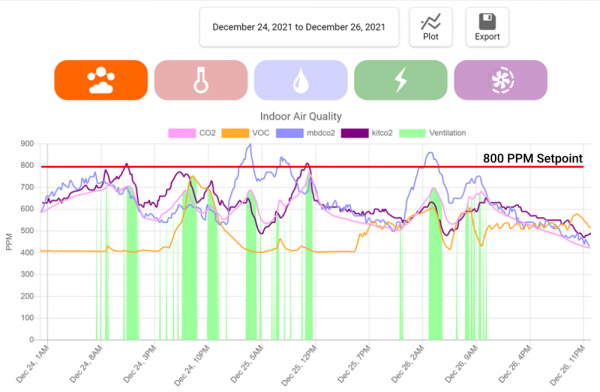Powder rooms, guest bathrooms, and master bathrooms must be ventilated! Poorly ventilated bathrooms become mold and mildew incubators that degrade bathrooms and home occupant health. Minimizing bathroom odor is also highly desirable!
Bathrooms and kitchens are relatively small areas with high pollutant generation that need immediate attention for relatively short periods of time (check out our recent Kitchen Ventilation article). Drying a “wet” bathroom requires more than simply running an exhaust fan for 15 minutes. The initial steam from a shower takes a brief amount of ventilation, but truly drying a bathroom’s wet surfaces and towels require more time. Almost a pint of water per day per person must be dried from a bathroom’s shower stall surfaces, towels and washcloths (see Table 1, page 13 of our Handling Humidity report #1). Unlike the steam from a hot shower, water absorbed in towels and beaded up on shower stall surfaces takes time to vaporize and dry out.
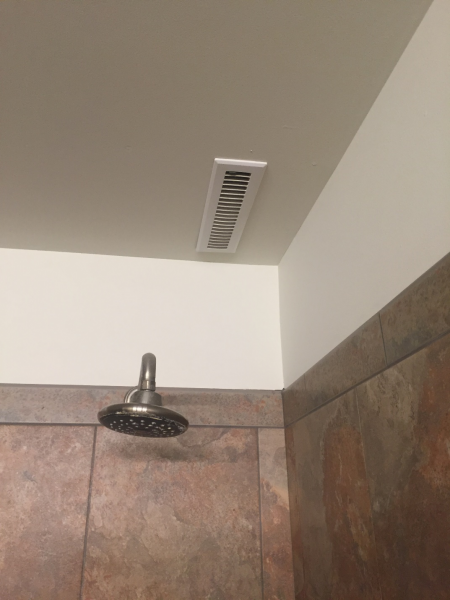
We discuss two common ways the CERV2 can be used to manage bathroom ventilation.
- Triggered exhaust mode with fan speed increase
- Triggered exhaust mode with zone dampers
Equinox House with 2.5 bathrooms, built in 2010, has been smart ventilated for 11 years. The first 10 years were ventilated with our first generation CERV using triggered exhaust mode ventilation. We replaced the first gen CERV with a CERV2 a year ago. Supply zone dampers and exhaust zone dampers were also added along with an array of our wireless plug-n-play sensors to demonstrate Build Equinox’s precision ventilation capabilities.
In CERV2 smart ventilated homes, fresh air follows you around your home and bad air is removed from its source!
Triggers
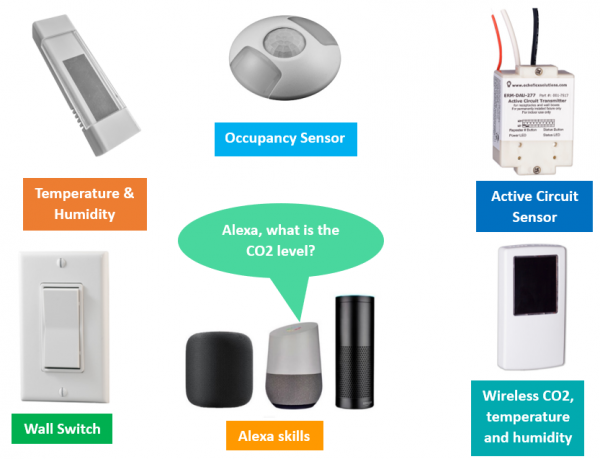
Triggers are switches or sensors that detect occupancy, activities, and pollutant generation in different regions of a home. Figure 2 shows some of the CERV2’s plug-and-play sensors and switches. Alexa can also communicate with the CERV2, and you can create your own custom skills, too!
The simplest trigger is a wall switch that is pressed when increased ventilation is desired. Each of our wireless wall switches has its own ID code. Each bathroom can have different ventilation time durations and exhaust fan speeds set that are linked to each switch. A powder room might have a shorter ventilation duration time and a lower fan speed than a master bathroom. Note that fresh air is never wasted in CERV2 smart ventilated homes unlike today’s conventional constant ventilation flow systems (ERVs and HRVs). CERV2 ventilation periods freshen the overall house and reduce the need for future house ventilation.
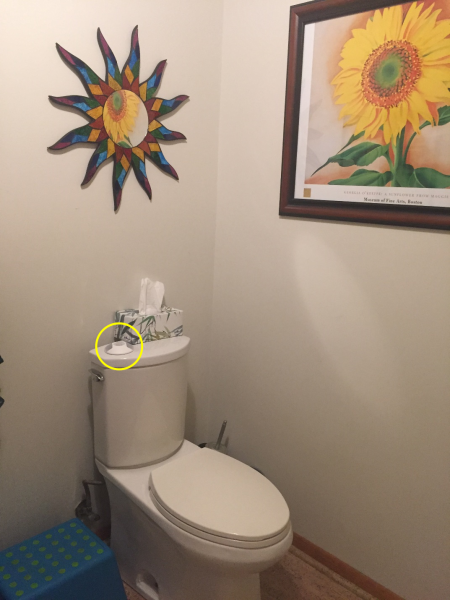
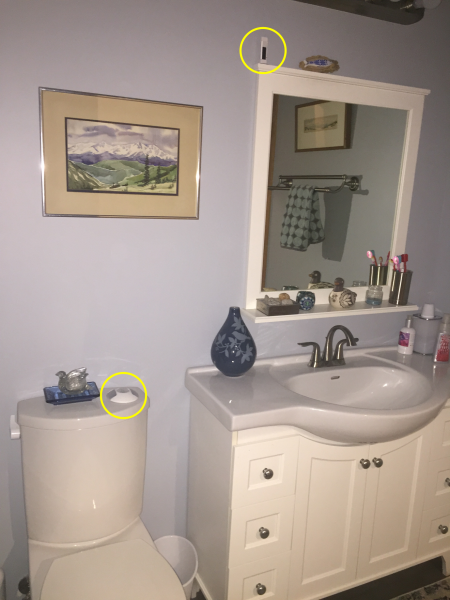
Some sensors automatically detect occupancy, and do not rely on a human to trigger exhaust ventilation. Studies continually show that building occupants rarely activate exhaust ventilation fans. Our passive occupant sensors are programmed by homeowners for a desired exhaust ventilation time and fan speed. Figures 3 and 4 show occupancy sensors in the powder room and guest bathroom in Equinox House. “Active circuit transmitters” (ACTs) sense when electric circuits for lights or other circuits are active. When someone turns a bathroom light on, the ACT chirps a message to the CERV2 to switch to a desired operation mode.
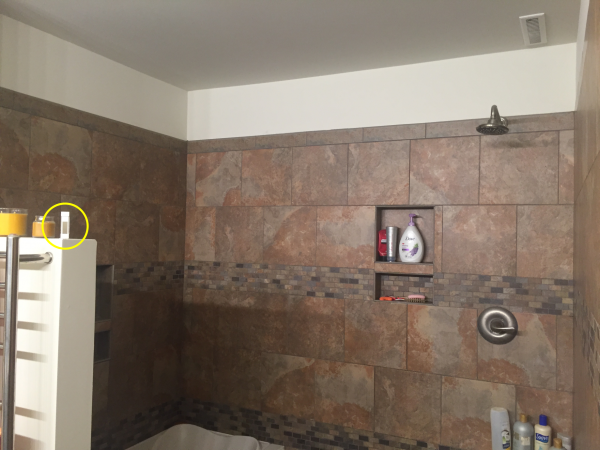
Temperature/humidity sensors and temperature/humidity/CO2 sensors continuously monitor a room’s air quality for pollutants and moisture to determine whether a change in room ventilation is needed. Figures 4 and 5 show our doorbell-size, wireless temperature/humidity sensors in the guest bathroom and master bathroom in Equinox House.
The guest bathroom has both occupancy sensor and temperature/humidity sensor. Overnight guests using the shower and bath increase bathroom humidity that is sensed by the temperature/humidity sensor, while other guests who are using the bathroom are sensed with the occupancy sensor for automated bathroom exhaust.
Triggered Exhaust Mode with Fan Speed Increase
The simplest method for bathroom ventilation is a wall switch that triggers the CERV2 to switch to exhaust mode with and elevated fan speed. Any of the other triggers in Figure 2 can be used in addition or in place of a wall switch. When exhaust mode is triggered, the CERV2 switches into exhaust ventilation mode operation for a user-defined period of time with a user-defined fan speed.
ASHRAE 62.2-2019 (“Ventilation and Acceptable Indoor Air Quality in Residential Buildings”) is the basis for today’s home ventilation standards. Section 5 on “Local Exhaust” specifies 50cfm bathroom exhaust capacity. For homes with 3 bathrooms or less, 150cfm of total bathroom exhaust capacity is required. Kitchens are required to have 100cfm of exhaust air flow capacity, for a combined exhaust air flow of 250cfm.
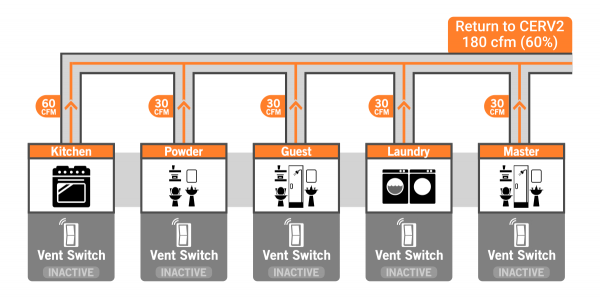
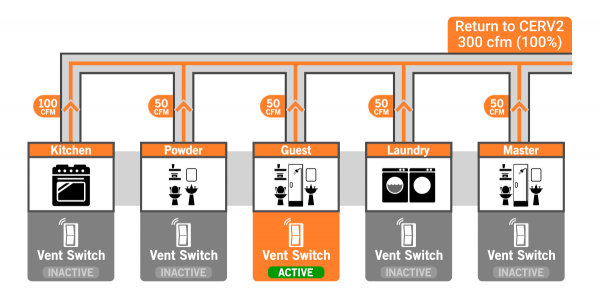
Figures 6 and 7 show schematics of the exhaust ventilation system in Equinox House. Figure 6 shows air flow when no exhaust ventilation is triggered. When a ventilation switch in any bathroom or kitchen is pressed, the CERV2 switches to exhaust mode and increases fan speed for a user defined period of time (eg, 15 minutes, 30 minutes, etc).
The CERV2 has an upper airflow of 300cfm at 100% fan speed setting. During normal CERV2 operation, the CERV2’s fans may be operating in the 50 to 70% fan speed range for an airflow of 150 to 200cfm. Figure 6 shows 30cfm return air flow for the 3 bathrooms and laundry room and 60cfm return flow from the kitchen for an overall air flow of 180cfm. Figure 7 shows CERV2 air flow increased to 300cfm, with bathrooms and laundry air flows increased to 50cfm and the kitchen air flow increased to 100cfm in line with ASHRAE62.2 local exhaust requirements.
Increasing CERV2 fan speed increases all room air flows in a proportional manner. That is, if a change in fan speed doubles the overall system air flow rate, all branch air flows are doubled, too. Read our Ductology reports (Report 1 and Report 2) to learn the theory behind proportional air flow among branches, but be sure to have a pot or two of coffee nearby.
Equinox House used this method for bathroom and kitchen ventilation for 10 years, as mentioned, without any signs of mold or mildew in bathrooms. Smart ventilation works!
Triggered Exhaust Mode with Zone Dampers
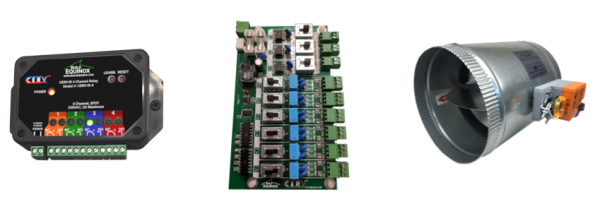
Zone dampering has the benefit of focusing exhaust ventilation where it’s needed most without needing to increase fan speed to reach elevated exhaust air flow rates. Zone dampering with the CERV2 is very easy to set up. Figure 8 shows wireless relay, CERV-IR, our wired expansion board, and a zone damper. CERV-IR has 4 damper relay connections. The expansion board has 6 damper relay connections. One internal relay is also included with the CERV2. Dampers sizes are available in 2” diameter increments starting at 4 inch dampers. The most common dampers are 6” and 8” for CERV2 ventilation systems.
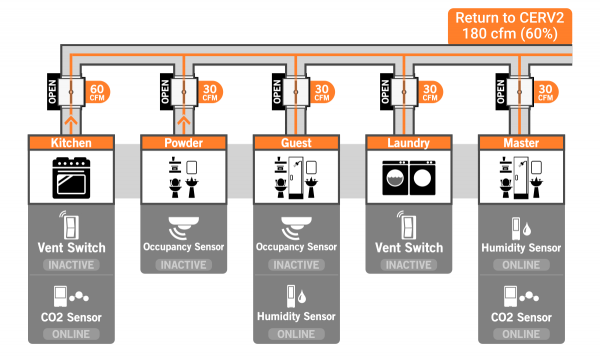
Figure 9 shows the current exhaust ventilation setup at Equinox House. We have 6” dampers in the 5 return branches. The kitchen and laundry room have wireless switches to trigger ventilation. The powder room and guest bathroom both have occupancy sensors, while the guest bathroom and master bathroom both have temperature/humidity sensors.
The kitchen and master bedroom have wireless CO2 sensors that detect elevated indoor pollutant levels, which triggers local exhaust venting. When pollutants are high in the bedroom at night, increasing exhaust ventilation through the mast bathroom while decreasing exhaust air flow in other unoccupied areas increases the flow of air through the mast bedroom. Similarly, high pollutant levels in the open living, dining, kitchen area triggers enhanced exhaust through the living area.
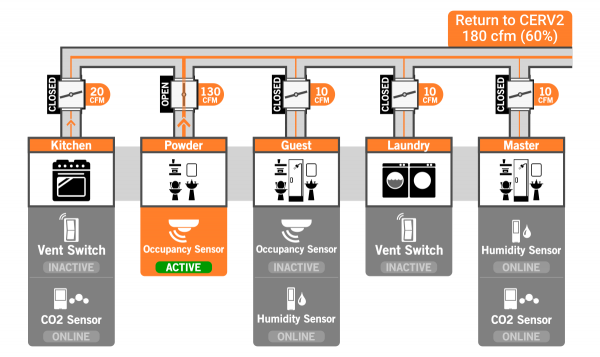
Figure 10 shows how the zone dampers respond to a local exhaust event in the powder room when the occupancy senses someone. Dampers in all unoccupied zones are partially closed (to about 20-30% of full open flow), while the occupied powder room damper stays full open. Assuming good duct design (good duct design means all branches and trunks keep air velocities in the 300 to 400fpm range (read our Ductology reports to learn why this air velocity is the most economical and practical flow rate). Zone dampering allows the CERV2 to provide enhanced exhaust ventilation without increasing overall system air flow. In comparison with Figure 7 that increased overall air flow to 300cfm in order to exhaust 50cfm from a bathroom, Figure 10 shows an increased bathroom exhaust airflow of 130cfm with an overall system air flow of 180cfm. Pretty cool!
Zone dampering is complex, but our CERV2 plug-n-play capability makes installing and programing sensors and relays easy. Equinox House currently has 12 wireless sensors and relays (actually, several more than that, but that’s for another time). You can literally set up 12 sensors and relays in 12 minutes. Our user interface guides you through each step as you add dampers and sensors, and then link them together. Would you like switch 1 to operate damper 3, and sensor 4 to trigger dampers 2 and 5? No problem!
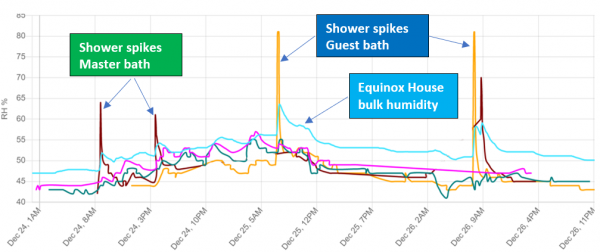
Figure 11 shows the proof-of-the-pudding. Over the recent holidays when guests stayed at Equinox House, fresh air venting and stale air exhausting were frequently required. The top plot shows the complexity of CO2 and VOCs variations in the house. Blowing air into a house is easy. Effectively delivering filtered fresh air to where it is needed, when it is needed is complex. In fact, much more complex than maintaining temperature in a home. We keep CO2 and VOC concentrations setpoints at 800ppm. At night, the master bedroom increases above 800ppm, triggering other exhaust dampers to partially close while keeping the master bathroom zone damper open. The green bars show time periods with CERV2 exhaust ventilation. During the day, the open living room and kitchen area will often exceed 800ppm threshold, causing other return zone dampers to partially close while the kitchen damper stays fully open.
Several thin green lines in Figure 11 are time periods when the bathrooms are used (old people use bathrooms a lot). The relative humidity plot in the lower Figure 11 plot shows “shower spikes” in the master bathroom and guest bathroom. These spikes indicate a moisture increase, with the wireless temperature/humidity sensors triggering an exhaust venting event with zone dampers adjusting as needed.
Conclusion
As we begin this new year, we will continue to work to raise awareness of the importance of indoor air quality on our health and well-being. We will continue to create new technologies and capabilities that seamlessly allow us to live our lives and do the things we enjoy doing in an energy efficient, sustainable, automatically maintained, healthy indoor environments!





